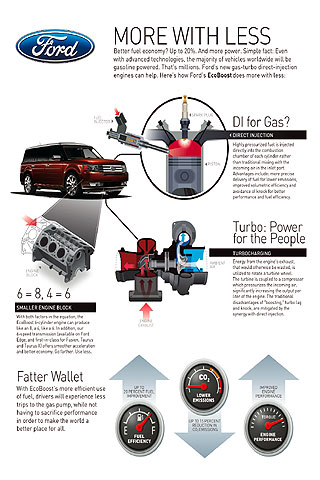 EcoBoost combines two proven technologies - direct injection and turbocharging
Ford EcoBoost technology
EcoBoost combines two proven technologies - direct injection and turbocharging
Ford EcoBoost technology
Many wonder if the new CAFE standards calling for much higher fuel economy will mean the end of performance cars. Probably not. For example, Ford believes less expensive gasoline engines will still power the majority of vehicles for many more years. While developing hybrid and fuel cell vehicles, Ford is working more efficient gasoline engines with greatly improved fuel economy and reduced emissions without sacrificing performance.
One example is Ford's new EcoBoost that combines two proven technologies - direct injection and turbocharging - with today's affordable gasoline engine designs. Compared to conventional port injection now commonly used, fuel is injected directly into each cylinder in small, precise amounts. The resulting cooler and denser charge results in greater fuel economy and improved performance.
When coupled with turbocharging, which uses the exhaust gas' waste energy to drive the turbine, EcoBoost allows a smaller displacement engine to produce the same, or even more, torque as a larger, more fuel thirsty, displacement engine. Furthermore, EcoBoost delivers up to 20 to 30 percent better fuel economy and comparable reductions in carbon dioxide emissions.
First planned for use in 2009 Lincoln MKS, most likely it will be used in the 2010 Mustang. Indeed, Ford recently said it plans to install EcoBoost technology in half a million Ford, Lincoln and Mercury vehicles annually over the next five years. This includes both four-cylinder and V8 engines in vehicles ranging from the F-150 trucks to the new Ford Flex crossover vehicle.
For the 2009 Lincoln MKS luxury sedan, a 3.5-liter twin-turbocharged V6 will produce the horsepower and torque of a V8 engine with the fuel efficiency of a V6. With an estimated 340-horsepower and more than 340 lb.-ft. of torque over a wide rpm range (2,000 to 5,000 rpm) the Lincoln MKS will be the most powerful and fuel-efficient all-wheel-drive luxury sedan on the market. This compares to a conventional, naturally aspirated 4.6-liter V8 that produces 270 to 310 lb.-ft of torque for over the same rpm range.
While this V-8 would be also ideal for performance Mustangs, a 2.0L four-cylinder EcoBoost engine could be the base Mustang engine. A four-cylinder, 2-liter version engine with EcoBoost technology could deliver 275 horsepower and 280 lb.-ft. of torque.
Broad torque bands means EcoBoost engines would be well suited for towing and off-road duty making it a viable alterative to more expensive diesel engines. Unlike also more expensive hybrids that are most efficient in stop-and-go traffic, an EcoBoost engine is efficient under both city and highway driving conditions.




